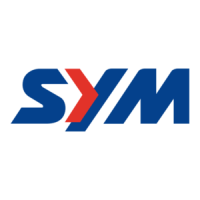
Do you have a question about the Sym gts 300 and is the answer not in the manual?
| Front Suspension | Telescopic Fork |
|---|---|
| Width | 760 mm |
| Displacement | 278 cc |
| Fuel System | Electronic Fuel Injection (EFI) |
| Cooling System | Liquid Cooled |
| Transmission | Automatic CVT |
| Rear Suspension | Dual Shocks |
| Front Brake | Disc |
| Rear Brake | Disc |
| Fuel Capacity | 12 L |
| Engine Type | Single-cylinder, 4-stroke |
Overview of dashboard indicators and their functions.
Explanation of gauge buttons and their operations.
How the fuel gauge works and its warning indicators.
Functionality and safety precautions for the side stand indicator.
Description of total and trip odometer functions.
Explanation of the coolant temperature indicator and related cautions.
Procedure for setting the clock display.
Details on ignition switch positions and key operations.
Explanation of various handlebar controls and buttons.
Function of headlight, taillight, and position lights.
How to use the engine stop switch for emergencies.
Operation of the seat opening mechanism.
How to use the electric starter button safely.
Operation of the headlight high and low beam switch.
Function of the passing light switch for signaling.
How to use the horn button.
Operation of the hazard warning lights.
Use of the fog lamp switch.
How to operate turn signal lights for turning.
Information on the accessory power socket.
How to use the goods hook.
Procedures for locking and unlocking the saddle.
Details about the under-seat storage box capacity and use.
How to deploy and retract the pillion step.
Instructions for opening and locking the fuel tank cap.
Guidelines for safe and effective braking.
How to use engine braking for speed control.
How to operate the throttle for acceleration and deceleration.
Step-by-step instructions for parking the scooter.
Checklist for regular pre-ride inspections.
Procedures for checking and changing engine oil.
How to clean the oil filter element.
Checking fuel level and type.
Procedures for checking and changing transmission oil.
How to check and adjust brake lever free play.
Visual inspection of disc brake components.
How to check front brake pad wear.
Checking the brake fluid level.
Procedure for adding front brake fluid.
Adjusting the throttle valve handle cable clearance.
How to inspect and maintain the battery.
Instructions for cleaning battery terminals.
Checking tire pressure, wear, and condition.
Inspecting front shock absorbers and steering.
Adjusting the rear cushion hardness.
How to check and replace fuses.
Verifying turn signal lights and horn operation.
Verifying front and rear light functionality.
Checking the operation of the brake light.
Inspecting fuel system components for leaks.
Checking lubrication points on the scooter body.
Inspecting and adjusting the spark plug gap.
Checking coolant level and system for leaks.
Procedure for refilling the coolant.
Cleaning deposits from the blow-by ventilation hose.
How to inspect and clean the air cleaner.
Inspecting the left crankcase cover air cleaner.
Troubleshooting steps when the engine fails to start.
